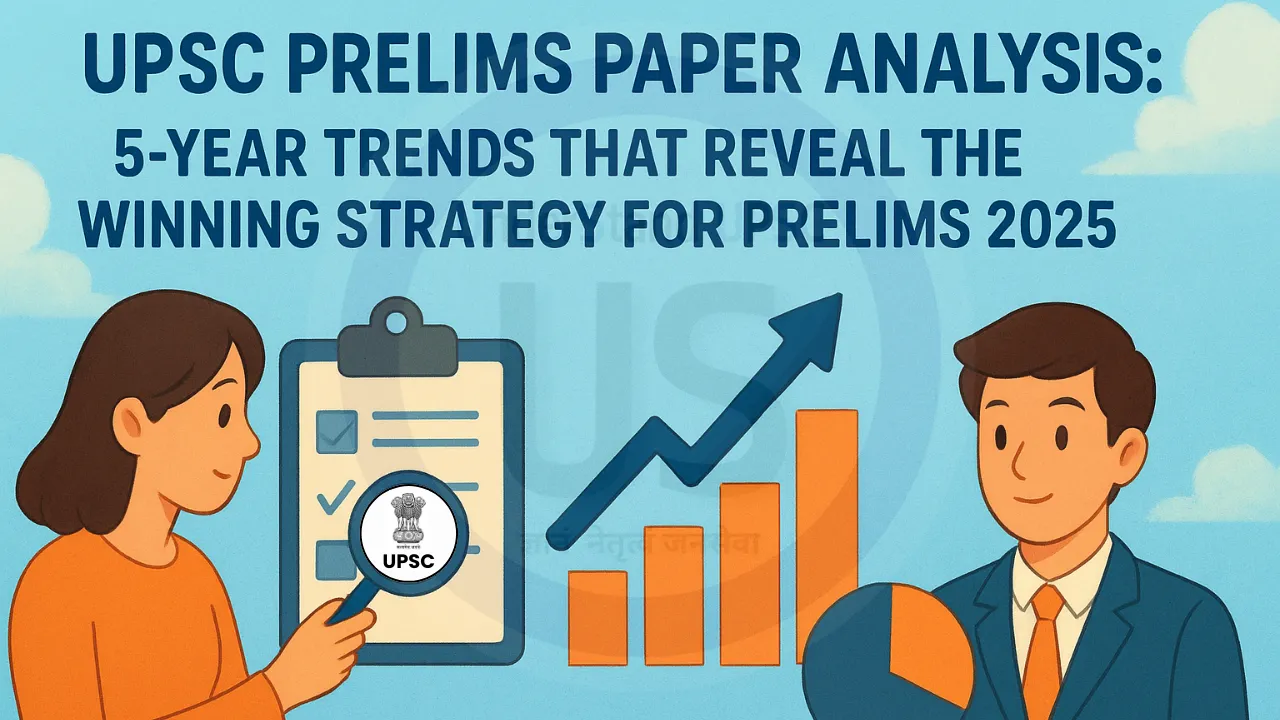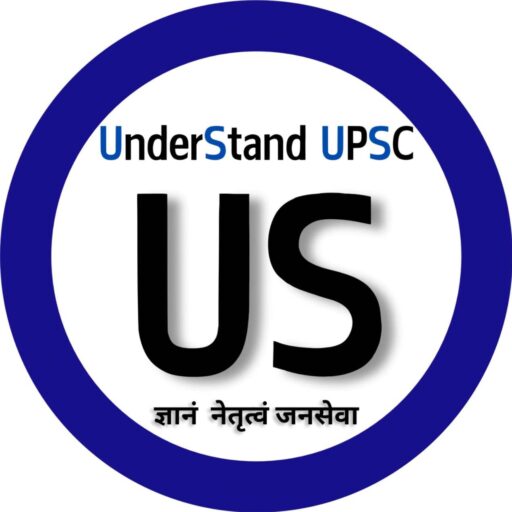Why Inspect Past Years?
India’s UPSC exam is known for its unpredictability. Yet, when you do a UPSC prelims paper analysis, you notice patterns. These patterns help aspirants like you prepare smarter. Today, over 14,000 candidates cleared Prelims 2025 nationwide, influenced by schemes like Tamil Nadu’s Naan Mudhalvan. Looking at the past five years offers insights on how best to raise your chances.

1. Subject‑wise Weightage: The Core Areas
A clear UPSC prelims paper analysis shows that roughly 70–75 questions come from six major subjects:
- History — 14–20 Qs
- Geography — 10–18 Qs
- Polity — 14–18 Qs
- Economy — 13–16 Qs
- Environment & Ecology — 12–21 Qs
- Science & Technology — 7–14 Qs
- Current Affairs— 11–24 Qs across years
For example, in 2023:
- History – 14 Qs
- Geography – 16 Qs
- Polity – 15 Qs
- Economy – 14 Qs
- Environment – 14 Qs
- Science & Tech – 12 Qs
- IR & Misc – 11 Qs
What this means for you: Prioritise History, Geography, Polity first, then move to Economy, Environment, and Science & Tech. Current affairs run across all these, so you need a strong grip on news linked to these subjects.
2. Yearly Shifts: What Stood Out
Here’s how subject weight shifted from 2021 to 2024:
| Year | History | Geography | Polity | Economy | Env & Ecology | Sci & Tech | Current Affairs |
| 2021 | 20 | 10 | 14 | 10 | 11 | 8 | 27 |
| 2022 | 10 | 10 | 11 | 16 | 17 | 14 | ~10 |
| 2023 | 14 | 16 | 15 | 14 | 14 | 12 | 11–15 |
| 2024 | 10–12 | 8–18 | 14–16 | 14 | 15–21 | 13 | 13–24 |
- 2021–22: High emphasis on History, Ecology, Science
- 2022–23: Economy & Geography regained ground
- 2024: Balanced approach; Environment and Science regained momentum.
UPSC prelims paper analysis reveals that no subject is safe to ignore—guarantee moderate prep across the board, with deeper focus on the heavy-hitters.
3. Current Affairs: Ever‑Shifting, Always Essential
One key insight from UPSC prelims paper analysis is that current affairs remain volatile but vital—ranging from 11% to 24%. In 2021, it was 27%; in 2024, it hovered around 13–24%.
Smart tip: Use monthly compilations (like Understand UPSC’s monthly current affairs) and track national/international themes that tie into GS topics. Don’t study news in isolation—link them back to History, Geography, Polity, or Environment.
4. Environment & Ecology: The Rising Star
Environment & Ecology climbed from 11 Qs in 2021 to over 20 in some years. Issues like climate treaties, biodiversity, pollution, wildlife conservation, and global summits dominate questions .
Action Plan:
- Stay updated on UNFCC, Convention on Biodiversity, IPCC reports
- Use Environment textbooks plus reliable current affairs sources
- Solve past 5–10 years of Environment PYQs
5. Science & Technology: Basic Concepts, Big Payoff
Science & Tech questions increased from about 8 in 2021 to 14 in 2022, and settled at 12–13 in 2023–24.
✔️ Focus areas:
- Space missions (Chandrayaan, NASA, ESA)
- Biotechnology developments
- Digital tech (AI, blockchain, quantum computing)
- Health tech (vaccines, diagnostics)
Link each development to current events. For example, a recent vaccine rollout ties into current affairs.
6. Polity & Governance: Stable but Deep
Polity consistently gave ~14–16 questions each year. In 2023, 15 Qs. These include Indian Constitution amendments, structure of government, fundamental rights, and current issues like state autonomy or money bills.
Study Tip:
- Use NCERTs and Laxmikanth for theory
- Practice objective questions regularly
- Follow understandupsc.com’s polity blogs and mock-test links
7. Geography & Economics: The Balancing Act
- Geography: 8–18 Qs
- Economy: 13–16 Qs
Physical geography, agriculture, resources, and map-based questions still feature heavily. The economy focuses on banking, macro indicators, and the government. schemes.
Prep Strategy:
- Draw maps, use mind maps for economics concepts
- Track Union Budget, RBI policy updates
- Solve sectional tests from Understand UPSC
8. History: From Macro to Micro
History ranged from 10 to 20 Qs. In 2021 it peaked at 20 Qs, while 2022 dipped to 10.
Core Areas:
- Modern history and national freedom movement
- Ancient and medieval cultural questions
- Art & culture, heritage sites
- World history in some years
Suggested prep:
- Mix NCERTs + Current affairs for heritage & culture
- Understand timelines instead of rote dates
9. CSAT: Still Qualifying, Still Important
CSAT continues as qualifying (33%). Quantitative aptitude weight reached 44 Qs in 2023 while reading & reasoning remained steady (~25–30 Qs).
Never neglect CSAT. Practice RC passages and math sets daily to clear the cut-off and reduce stress.
10. Putting It All Together: Your Action Plan
Here’s a weekly schedule aligned with UPSC prelims paper analysis:
- Sunday review: Summarize current affairs linked to GS subjects.
- Daily prep:
- History – 45 mi
- Polity – 45 min
- Geography – 45 min
- Economy – 45 min
- Environment & Science – alternate days
- CSAT practice – 30 min
- Weekend mocks:
- 1 full GS paper + 1 CSAT paper every Sunday
- Check solutions, track performance
- Monthly analysis:
- Compare with past year trends
- Identify weak areas
This method uses recommendations from Satyam Jain Sir at Understand UPSC. It keeps you aligned with trends while building consistency.
11. How Understand UPSC Can Help
At Understand UPSC, our monthly current affairs, trend‑based quizzes, and mock tests are tailored to these insights. We track patterns, host live sessions with Satyam Jain Sir, and provide answer-writing practice that targets this evolving landscape—ensuring candidates stay ahead of curve.
Here are some internal links you should check:
- Current Affairs compilation
- Mock test series registration
- Polity question bank
Final Take
A smart UPSC prelims paper analysis shows:
- Stick to core subjects but don’t neglect Environment, Science & Current Affairs
- CSAT is no place for shortcuts
- Use trend-based prep tools (like those from Understand UPSC & Satyam Jain Sir)
- Regular mocks + performance checks = better scores
By combining a consistent study schedule with pattern insights, you boost your chances of clearing Prelims 2025. Stick with this plan—stay calm and focused. You’re closer than you think!




